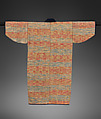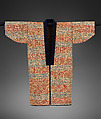Returned to lender The Met accepts temporary loans of art both for short-term exhibitions and for long-term display in its galleries.
Farmer’s Jacket (Shigotogi)
Not on view
Probably once owned by a well-to-do farmer, this stylish and sturdy jacket is made with alternating blue, green, pink, red, and orange scraps of fabric of various widths. Strips of cotton were reused as wefts, woven together with warps of mountain wisteria (tree-bast fiber, yamafuji) in a plain-weave technique known as sakiori. This method began as a means of recycling old textiles, mainly cotton, which were too valuable to discard. Often women wove sakiori textiles on a traditional backstrap loom, using a heavy batten or hand-beater to force the thick weft into place. This jacket’s pristine condition suggests that it was never worn. Very few antique farmer’s jackets survive.
Due to rights restrictions, this image cannot be enlarged, viewed at full screen, or downloaded.
This artwork is meant to be viewed from right to left. Scroll left to view more.



